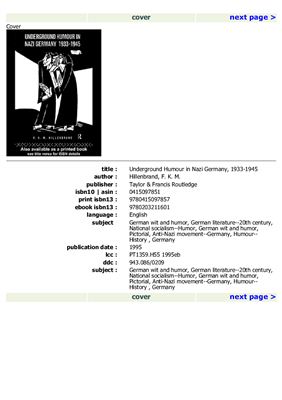Lnd.: Taylor & Francis Routledge, 1995. - 296 р.
Underground Humour in Nazi Germany: 1933-1945, F. K. M. Hillenbrand compiles a collection of jokes, stories and cartoons representing covert popular opposition which took humorous form. Even this was dangerous, as an ill-judged moment of wit could lead to the camps; but the Nazis themselves recognized the impossibility of stopping anti-Nazi jokes.
Although wonderfully entertaining, Underground Humour in Nazi Germany:1933-45 is not a joke book, but a serious study of the uses of humor and word play, supplemented always with full translations and explanations when a joke is retold. Hillebrand explains not only how humor could be used subversively in the Third Reich, but also suggests the ways that people resist under any totalitarian conditions, not exclusively Nazi Germany.
Underground Humour in Nazi Germany: 1933-1945, F. K. M. Hillenbrand compiles a collection of jokes, stories and cartoons representing covert popular opposition which took humorous form. Even this was dangerous, as an ill-judged moment of wit could lead to the camps; but the Nazis themselves recognized the impossibility of stopping anti-Nazi jokes.
Although wonderfully entertaining, Underground Humour in Nazi Germany:1933-45 is not a joke book, but a serious study of the uses of humor and word play, supplemented always with full translations and explanations when a joke is retold. Hillebrand explains not only how humor could be used subversively in the Third Reich, but also suggests the ways that people resist under any totalitarian conditions, not exclusively Nazi Germany.

